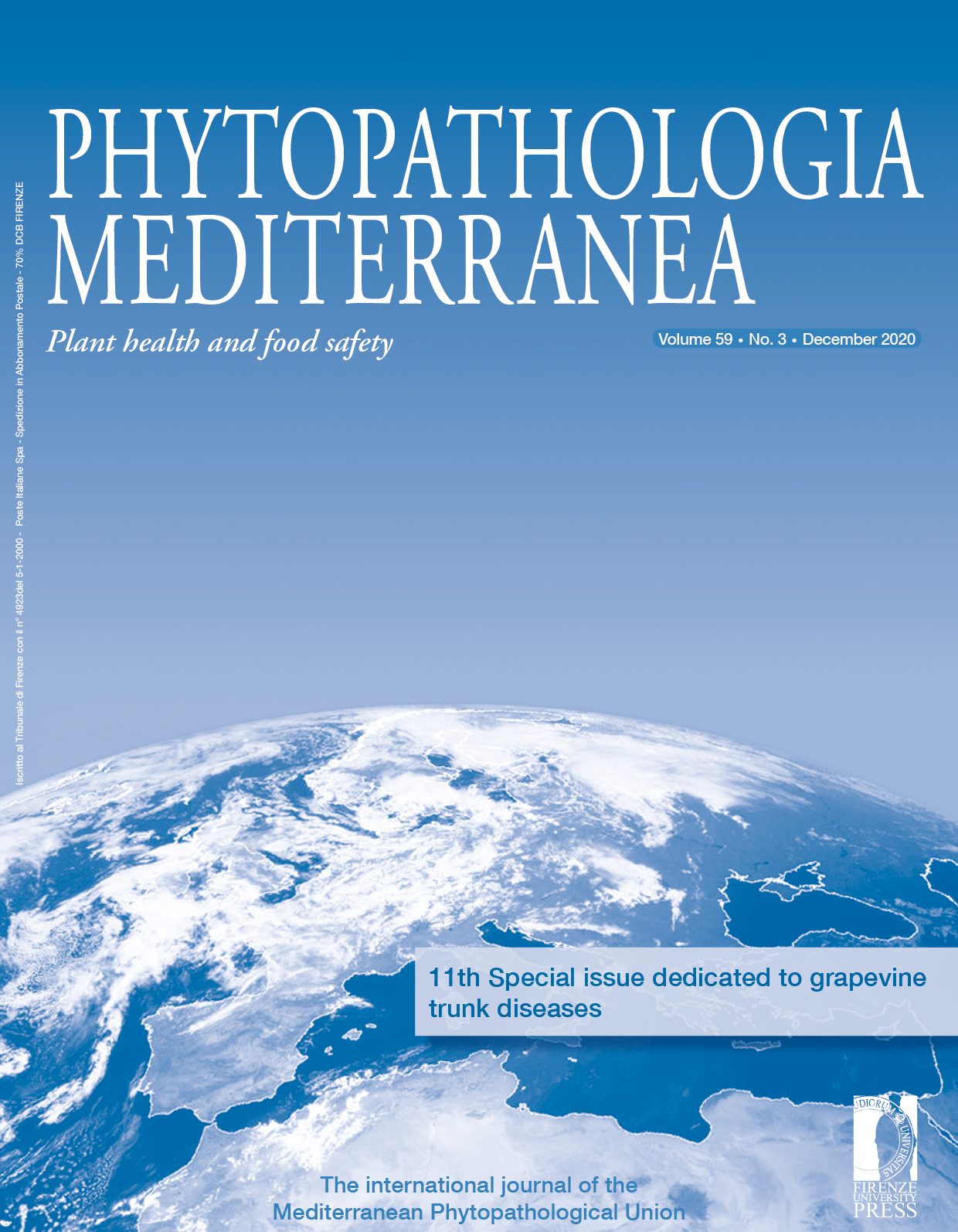Published 2020-12-25
Keywords
- Diaporthales,
- Melanconiellaceae,
- multilocus typing,
- grapevine trunk diseases
How to Cite
Abstract
The state of Sonora is the main grape production area in Mexico. Grapevine trunk diseases (GTD) are serious disease in this region. During the springs of 2017 and 2018, symptoms of yellow and wilted leaves, and necrotic buds, were observed in several vineyards in Sonora. Affected plants had numerous small, black and bright acervuli. This study aimed to identify the causative agent of this disease. Isolates were obtained from small pieces of damaged plant parts, and were cultured on potato dextrose agar. The developing mycelium was white but turned greyish white after 3 d. Multi-shaped black mucilaginous droplets appeared in the cultures after 2 d, and the agar in Petri dishes was completely covered with mycelium after 7 d, and the colonies had five or six rings with large numbers of conidiomata. Conidia were hyaline or light cream, fusiform, oval or ellipsoid, with truncated bases and narrow almost pointed apices, and were 6–10 mm long and 2–3 mm wide. Phylogenetically analysed concatenated sequences of the DNA from two representative isolates, from the internal transcribed spacer region, and large ribosomal subunit, showed they were in a separate clade which aligned with several strains of Greeneria uvicola, confirming the presumptive morphological identity of the isolates. This cosmopolitan ascomycete is responsible for bitter rot of grapes, but the role of this fungus as a cause of grapevine trunk diseases is little known. Pathogenicity tests of the isolates were performed on 1-year-old ‘Passion Fire’ grapevines plants, one of the new cultivars planted in Sonora. All of strains G. uvicola were pathogenic, and the fungus was recovered from the lesions, fulfilling Koch’s postulates. This is the first report on the pathogenicity of G. uvicola in wood tissues of Vitis vinifera in Mexico.
Downloads
References
Agustí-Brisach C., Armengol, J., 2013. Black-foot disease of grapevine: an update on taxonomy, epidemiology and management strategies. Phytopathol. Mediterr. 52:245-261.
Carlucci A., Lops F., Mostert L., Halleen F., Raimondo M. L., 2017. Occurrence fungi causing black foot on young grapevines and nursery rootstock plants in Italy. Phytopatholigia Mediterranea 56: 10-39.
Castillo-Pando M., Somers A., Green C. D., Priest M., Sriskanthades, M., 2001. Fungi associated with dieback of Semillon grapevines in the Hunter Valley of New South Wales. Aust. Plant Pathol. 30: 59-63.
Farr D. E., Castlebury L. A., Rossman A. Y., Erincik O., 2001. Greeneria uvicola, cause of bitter rot of grapes, belongs in the Diaporthales. Sydowia 53: 185-199.
Felsenstein J. 1985. Confidence limits on phylogenies: An approach using the bootstrap. Evolution 39: 783-791.
Gramaje D., Armengol J., 2011. Fungal trunk pathogens in the grapevine propagation process: potential inoculum sources, detection, identification, and management strategies. Plant Disease 95: 1040-1055.
Gramaje D., Úrbez-Torres J. R., Sosnowski M. R., 2018. Managing grapevine trunk diseases with respect to etiology and epidemiology: Current strategies and future prospects. Plant Disease 102: 12-39.
Kimura M. 1980. A simple method for estimating evolutionary rate of base substitutions through comparative studies of nucleotide sequences. Journal of Molecular Evolution 16: 111-120.
Kumar S., Stecher G., Li M., Knyaz C., Tamura K., 2018. MEGA X: Molecular Evolutionary Genetics Analysis across computing platforms. Molecular Biology and Evolution 35:1547-1549.
Larignon P., Dubos, B., 1997. Fungi associated with esca disease in grapevine. European Journal of Plant Pathology 103: 147-157.
Longland J. M., Sutton T. B., 2008. Factors affecting the infection of fruit of Vitis vinifera by the bitter rot pathogen Greeneria uvicola. Phytopathology 98: 580-584.
Mostert L., Groenewald J. Z., Summerbell R. C., Gams W., Crous P. W., 2006. Taxonomy and pathology of Togninia (Diaporthales) and its Phaeoacremonium anamorphs. Stud. Mycol. 54: 1-113.
Navarrete F., Abreo E., Bettucci L., Martínez S., Lupo S., 2009. First report of Greeneria uvicola as cause of grapevine dead-arm dieback in Uruguay. Australasian Plant Disease Notes. 4: 117-119.
Navarrete F., Abreo E., Martínez S., Bettucci L., Lupo S. 2011. Pathogenicity and molecular detection of Uruguayan isolates of Greeneria uvicola and Cadophora luteo-olivacea associated with grapevine trunk diseases. Phytopathol. Mediterr. 50, S166-S175
Rehner S. A., Samuels G. J., 1994. Taxonomy and phylogeny of Gliocladium analyzed from nuclear large subunit ribosomal DNA sequences. Mycol. Res. 98, 625−634.
Rudelle J., Octave S., Kaid-Harche M., Roblin G., Fleurat-Lessard P., 2005. Structural modifications induced by Eutypa lata in the xylem of trunk and canes of Vitis vinifera. Funct. Plant Biol. 32, 537–547.
SAGARPA, Secretaría de Agricultura, Ganadería, Desarrollo Rural, Pesca y Alimentación. 2018. Servicio de información agroalimentaria y pesquera. Available at: www.siap.gob.mx/index. Accessed December 10, 2019.
Saitou N., Nei M. 1987. The neighbor-joining method: A new method for reconstructing phylogenetic trees. Molecular Biology and Evolution 4: 406-425.
Scribner F. L., and Viala, P. 1887. Le Greeneria fuliginea, nouvelle forme de rot des fruits de lab vigne observee en Amärique. Comptes rendus Hebdomadaires des Séances de l’Académie des Sciences 105: 473.
Úrbez-Torres J. R., 2011. The status of Botryosphaeriaceae species infecting grapevines. Phytopathol. Mediterr. 50:S5-S45.
Úrbez-Torres J. R., Peduto F., Smith R. J., Gubler W. D., 2013. Phomopsis dieback: A grapevine trunk disease caused by Phomopsis viticola in California. Plant Dis. 97: 1571-1579.
Úrbez-Torres J. R., Leavitt G. M., Guerrero J. C., Guevara J., Gubler W. D., 2008. Identification and pathogenicity of Lasiodiplodia theobromae and Diplodia seriata the causal agents of Bot canker disease of grapevine in Mexico. Plant Dis. 92:519-529.
Vilgalys R., Hester M., 1990. Rapid genetic identification and mapping of enzymatically amplified ribosomal DNA from several Cryptococcus species. Journal of Bacteriology 172, 4238-4246.
White T., Bruns T., Lee S., Taylor J., 1990. Amplification and direct sequencing of fungal ribosomal RNA genes for phylogenetics. In PCR Protocols: A guide to methods and applications; Innis M. A. Gelfand D. H., Sninsky J. J., White T. J., Eds. Academic Press: New York, NY, USA, pp. 315-322.
Wilcox W. F., Gubler W. D., & Uyemoto J. K. (Eds.). 2015. Compendium of grape diseases, disorders, and pests (pp. 39-45). APS Press, The American Phytopathological Society.






